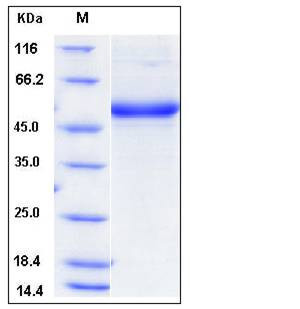Mouse CD302 / CLEC13A Protein (Fc Tag)
1110055L24Rik,AI159627
- 100ug (NPP2680) Please inquiry
| Catalog Number | P50706-M02H |
|---|---|
| Organism Species | Mouse |
| Host | Human Cells |
| Synonyms | 1110055L24Rik,AI159627 |
| Molecular Weight | The secreted recombinant mouse CD302/Fc is a disulfide-linked homodimer. The reduced monomer comprises 377 amino acids and has a calculated molecular mass of 42.6 kDa. As a result of glycosylation, the apparent molecular mass of rmCD302/Fc monomer is approximately 48 kDa in SDS-PAGE under reducing conditions. |
| predicted N | Asp 21 |
| SDS-PAGE |  |
| Purity | > 93 % as determined by SDS-PAGE |
| Protein Construction | A DNA sequence encoding the extracellular domain of mouse CD302 isoform 2 (Q9DCG2-2) (Met 1-His 156) was fused with the Fc region of human IgG1 at the C-terminus. |
| Bio-activity | |
| Research Area | Cancer |Invasion microenvironment |Adhesion molecule |Cell adhesion |Lectin |C-tyep lectin | |
| Formulation | Lyophilized from sterile PBS, pH 7.4 1. Normally 5 % - 8 % trehalose and mannitol are added as protectants before lyophilization. Specific concentrations are included in the hardcopy of COA. |
| Background | CD302/CLEC13A (C-type lectin domain family 13 member A), also known as C-type lectin receptor DCL-1, is a type I transmembrane C-type lectin DCL-1/CD302. DCL-1 protein was highly conserved among the human, mouse, and rat orthologs. DCL-1 ectodomain contains only one CRD, whereas other type I transmembrane C-type lectins contain more than one domain (e.g. selectins and MMR). DCL-1 CP contains several putative motifs, including a Tyr-based internalization, a cluster of acidic amino acids, and Ser and Tyr phosphorylation motifs, suggesting that DCL-1 CP mediates not only endocytosis and late endosome targeting but also signaling. DCL-1 may be another cell/matrix adhesion receptor integrated in cell adhesion complexes and that DCL-1 dysfunction may affect APC adhesion and migration, causing suppression of APC function. |
| Reference |
